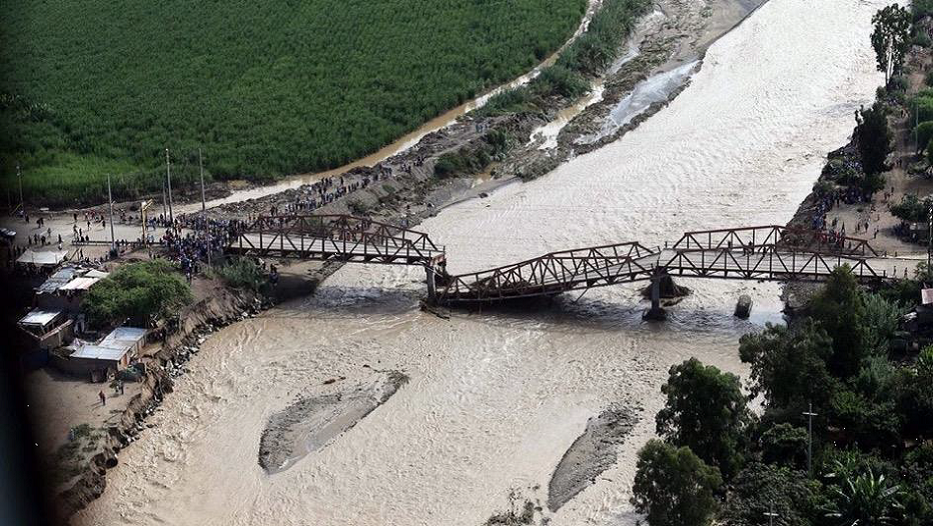admin | 26/06/2018
In March 2017, Peru suffered one of the most significant natural disasters in recent decades, the result of the weather phenomenon called “El Niño Costero”.
During the meteorological event known as “El Niño”, water temperatures increase along the equatorial strip of the Pacific Ocean, and the effects are felt across the world: light monsoon rains in India, colder European winters, typhoons in Asia and droughts in Indonesia and Australia.
However, when the warming takes place exclusively in the coastal region of Peru and Ecuador, a phenomenon of torrential rains occurs that is limited to these countries. This is known as “El Niño Costero”.
The phenomenon that materialized in March 2017, began in December 2016, when winds from the north, originating in Central America, triggered the displacement of warm water towards the south, as reported by ENFEN (1).
In its journey to the Ecuadoran and Peruvian coasts, this water mass did not encounter any resistance. Coastal winds blowing in the opposite direction, from south to north, weakened during the first days of December 2016, allowing the entry of warm water from Central America.
This abnormal warming of the sea in the coastal region began in the middle of January 2017, with water reaching maximum temperatures of 82.4 degrees Fahrenheit in Peru and Ecuador.
The excess temperature provokes a severe evaporation of water, which gives rise to widespread torrential rains that last several weeks without interruption.
This event affected 20 of Peru’s 25 regions, with significant loss of human life and property, including extensive destruction of media, roads and highways.
As a result of this weather phenomenon, the company AUTOPISTA DEL NORTE (GRUPO OHL) suffered Material Damage and Loss of Profit.
The policy, from the Completed Civil Works branch, was issued by MAPFRE PERÚ, with 75% of the risk.
The covered property that sustained the damage was Highway System no. 4, a 221-mile stretch between the Peruvian towns of Pativilca and Trujillo.
The processing of a claim, for a covered property as extensive as this, requires constant coordination and communication between the insured, the expert’s panel and the insurer.
The immediate presence of adjusters was crucial for the initial appraisal of the loss, as it was necessary in most cases to make the inspections on foot.
On the part of the insured, mitigation and cleaning work were extremely important, as was the work needed to restore vehicular traffic.
An indication of the complexity of a claim of this magnitude can be seen in a brief description of the damaged properties:
– Calzada Antigua (The Old Road): collapse of two bridges and severe damage to two others.
Safety and protection signs were partially destroyed, with the accumulation of water, mud and other displaced objects.
Embankments were damaged, there was loss of asphalt and hidden damage in the road was detected.
–On the Calzada Nueva (The New Road) , parallel to the above one, one of the bridges was completely destroyed and berms and shoulders were affected, in addition to more hidden damage.
The insured also suffered Loss of Profits as a result of toll roads being unable to operate.
The anticipated repair time to return things completely to normal exceeded the maximum compensation period of 12 months set in the policy.
The existence of concession contracts, signed by the insured with the Peruvian Ministry of Transportation and Communications, an additional insured on the policy, also had an impact on the loss adjustment. It was necessary to retain local legal services to study the obligations arising from these contracts in relation to the losses caused by the incident.


The difficulty in processing, from the point of view of the insurance contract, can also be gathered from the additional covers under the policy that were activated:
Salvage, Removal of Debris, Cleaning and Rescue
Provisional Repairs.
Professional Fees
Clean-up Costs and Sludge Removal
Public Authorities
Mitigation or salvage expenditure, and
Increase in building costs and damage to undamaged property.
The appraisal of damages and losses required numerous meetings with the insured for the exchange of opinions about the submitted claim, compensated items and their adjustment.
The spirit of cooperation and good faith among all the participants characterized the conversations, notwithstanding the legitimate defense of the respective positions.
Finally, an agreement was reached, that the insured and the insurer considered satisfactory, with a total and final compensation for all items.
In short, the mentioned claim is a good example of complexity due to the breadth and difficulty of appraising the damaged property.
At the same time, it is an example of professional excellence in expert management and in the attitude of the insured and the insurers regarding the claim, which was resolved satisfactorily.

(1) ENFEN. Peruvian multisector committee for the study of the “El Niño Costero” Phenomenon

Author: Román Guaita
Deputy Director of Claims at MAPFRE Global Risks





